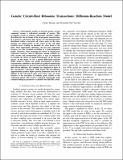Genetic Circuit-Host Ribosome Transactions: Diffusion-Reaction Model
Author(s)
Barajas, Carlos; Del Vecchio, Domitilla
DownloadMain article (983.3Kb)
Metadata
Show full item recordAbstract
Deterministic models of bacterial genetic circuits commonly assume a well-mixed ensemble of species. This assumption results in ordinary differential equations (ODEs) describing the rate of change of the mean species concentration. It is however well known that species are non-homogenously distributed within a bacterial cell, where genes on the chromosome are found mostly at the center of the cell while synthetic genes residing on plasmids are often found at the poles. Most importantly, ribosomes, the key gene expression resource, are also arranged according to a non-homogenous profile. Therefore, when analyzing the effects of sharing gene expression resources, such as ribosomes, among synthetic genetic circuits and chromosomal genes, it may be important to consider the effects of spatial heterogeneity of the relevant species.
In this paper, we use a partial differential equation (PDE) model to
capture the spatial heterogeneity of species concentration. Solutions to the model are gathered numerically and approximations are
derived via perturbation analysis in the limit of fast diffusion.
The solutions are compared to those of the conventional ``well-mixed'' ODE model.
The fast-diffusion approximation predicts
higher protein production rates for all mRNAs in the cell and in some cases,
these rates are more sensitive to the activation of synthetic genes relative to
the well-mixed model. This trend is confirmed numerically using common biological parameters to simulate the full PDE system.
Date issued
2018-09-18Keywords
Synthethic biology, PDE, Resource Sharing